Scientists involved in the most comprehensive study of life in the oceans ever conducted have documented changes in species distribution in the polar regions as warmer oceans spur migration
- guardian.co.uk, Sunday 15 February 2009 18.00 GMT

The Pelagonemertes rollestoni. Scientists found that at least 235 species live in both polar regions despite being 6,800 miles apart. Photograph: Russ Hopcroft, University of Alaska Fairbanks/Census of Marine Life
Global warming is changing the distribution, abundance and diversity of marine life in the polar seas with "profound" implications for creatures further up the food chain, according to scientists involved in the most comprehensive study of life in the oceans ever conducted.
Researchers from the Arctic Ocean Diversity (Arcod) project have documented rising numbers of warm-water crustaceans in the seas around Norway's Svalbard Islands. Arcod is part of the Census of Marine Life, a huge 10-year project involving researchers in more than 80 nations that aims to chart the diversity, distribution and abundance of life in the oceans.
They say an increasing number of these species are extending their range towards the poles as previously cold waters between Norway and the North Pole become warmer and more hospitable.
The team, led by Dr Rolf Gradinger, from the University of Alaska, also collected evidence from the polar Chukchi Sea, between Russia and Alaska, which showed that at least three species have extended their range northwards by up to 500km. The most notable is the snow crab, which has crossed the Bering Strait and is occurring in the Chukchi Sea for the first time.
"This is an example of a general trend we are observing where water is warming further north and making this region more suitable for southerly species," Gradinger said.
The Census is a huge 10-year project involving researchers in more than 80 nations that aims to chart the diversity, distribution and abundance of life in the oceans.
The team also found that smaller species are replacing larger ones in some Arctic waters, a shift which could have profound implications further up the food chain.
"We are finding two smaller species of plankton. This difference in size is big enough to cause a problem for the breeding populations of birds and whales as they will be forced to eat smaller species that has less energy content."
Gradinger's team of scientists from the University of Alaska and the Shirshov Institute of Oceanology in Moscow has collected its findings over five years. Their research has been released in conjunction with another survey from the Census of Antarctic Marine Life (CAML) following a series of expeditions during International Polar Year 2007-08. Both projects will contribute data on polar regions to the global Census of Marine Life, which is due to be released in 2010.
"In oceanographical terms these [Arctic] changes are huge," said Gradinger. "A change in temperature of just a few degrees will see the loss of sea ice cover and with it the sea ice algae, small animals and crustaceans which depend on it. By 2050 the arctic oceans may be ice free, we will lose these animals and that will have implications further up the food chain."
"From an Arctic perspective it's not only about an increase in temperature, it's a complete change in the ecosystem - salinity, ice melt, flow, currents - all of these together will have an impact."
The Antarctic team also reported evidence that some species of pteropods - snail-like species also known as sea butterflies - are moving further towards the pole. "It is similar to the Arctic – animals adapted to cold water environments are having to head to the poles to keep to colder climes as northern waters warm," said Dr Julian Gutt of the CAML.
By comparing notes, Arcod and CAML scientists found that at least 235 species live in both polar regions despite being 6,800 miles (11,000km) apart. Marine life that both poles share includes grey whales, birds, worms, crustaceans and pteropods. Scientists say the discovery opens a host of future research questions over where they originated and how they ended up at opposite ends of the earth.
Another major finding from the 18 research expeditions conducted by CAML during 2007-08 has revealed that life on the seafloor around the Antarctic continent forms a single bioregion - not separate ecosystems, as previously thought. Sampling from 1m locations around the 5,300 miles (8,500km) of Antarctic seafloor - or benthos - has also confirmed that the system is united by a single high-speed current.
"These findings are a major part of new information because so little was really known historically about these regions," said Ron O'Dor, the chief scientist of the census.
Gradinger added: "It's extremely difficult to get information from polar seas because we don't have good historical data. But we must collect data now to evaluate the impact of climate change and the use of the seas for tourism, fishing and shipping. With the warming of Arctic commercial exploitation might increase and therefore it's important to document what species are occurring currently."
Scientists from around the world have been involved in 17 different marine projects that will inform the census, a 10-year project that will provide a snapshot of life in the world's oceans.
The Earth's ice oceans have already revealed some secrets that have excited scientists. Last year at team of British Antarctic Survey scientists working on the census found that seas surrounding an archipelago near the tip of the Antarctic peninsula are richer in animal life than the Galapagos Islands, challenging the notion that warm seas in tropical zones are higher in biodiversity.
In February last year, giant sea creatures, including sea spiders the size of dinner plates and jellyfish with six-metre long tentacles, were found by Australian scientists working on a census project in the deep waters around Antarctica.

No comments:
Post a Comment